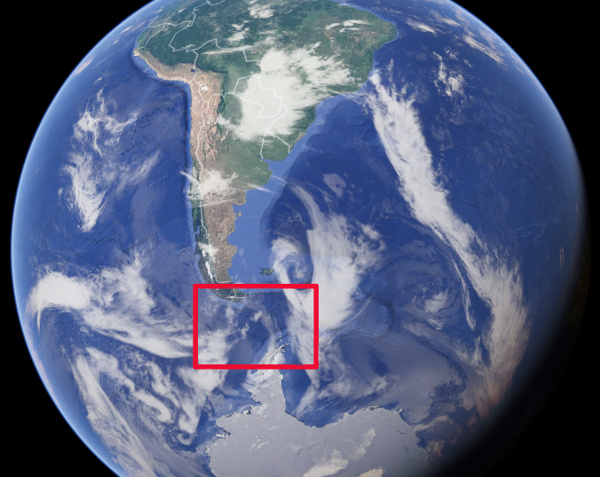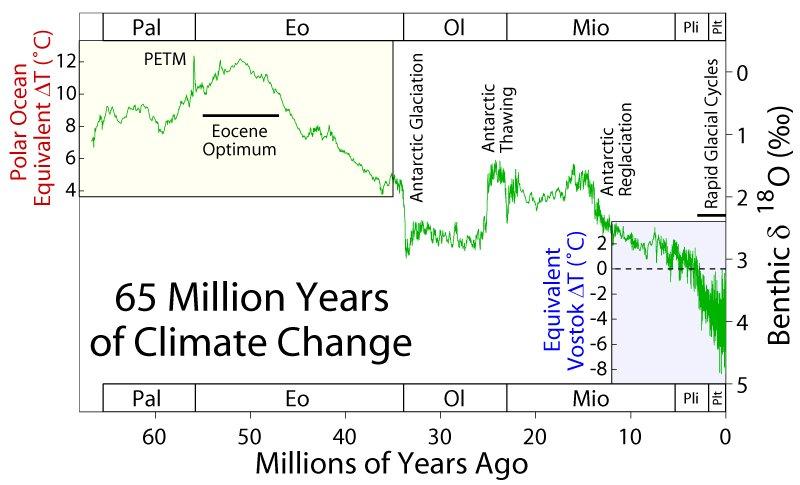I’m going to let you in on a little secret about a doomsday device that threatens with mass extinction of the vast majority of all species on Earth, including mankind. This device has been created 41 million years ago and has been steadily working on cooling the planet down, reducing the amount of CO2 in the atmosphere, increasing the temperature gradient between the poles and the equator. It has cooled the planet down so much that the existence of permanent ice sheets on the poles has become the norm for the last few millions of years. Lately, it rendered the climate so fatally unstable, that the Milankovitch cycles, the small variations in orbital eccentricity, axial tilt and precession, have become sufficient to plunge the planet into ice ages – or, considering that we are in an ongoing ice age, we should call those the “glacial maximums”. Inevitably, as the process of global cooling progresses, those small variations will at one point cease to be sufficient for bringing the planet out from a glacial maximum, and further on, it will cause a global glaciation, also known as “snowball Earth”.
This doomsday device is known in geography as the Drake Passage.

To quote Wikipedia, “There is no significant land anywhere around the world at the latitudes of Drake Passage, which is important to the unimpeded flow of the Antarctic Circumpolar Current which carries a huge volume of water (about 600 times the flow of the Amazon River) through the Passage and around Antarctica.”
Some 65 MY ago, due to plate tectonics things started taking place, that gradually rearranged the flow of sea currents around the continents. The Drake Passage was opened 41 MY ago, separating South America from Antarctica. This created a steady Antarctic circumpolar current which is basically a Coriolis-effect-driven heat pump, and you can understand how that works if you imagine a rotating cold vessel filled with liquid, where rotation of the vessel helps the exchange of heat between the two, only in this case the liquid flows outside the “vessel”. The liquid spins inside the vessel due to inertia. It essentially cools warm seawater by exchanging its heat with the edges of the polar continent where it dissipates into space. The effectiveness of this circumpolar current in dissipating the energy from Earth is such that it creates a net-negative energy balance, although a slight one, and creates a long-term trend.
This long-term cooling trend is what drove the evolutionary forces that created our kind of mammalian life, and it’s the trend that will eventually result in a complete global freeze that will produce the final extinction of our kind of mammalian life. This is the reason why there are no longer any large ectothermic creatures around, such as the Titanoboa, why the birds needed to evolve the ability to migrate seasonally in order to avoid the freezing cold of the north hemisphere winter, and why the mammals needed to evolve in order to hibernate. Closer to our time, the formation of the isthmus of Panama some 5 MY ago impeded the equatorial sea currents, forcing them to circumnavigate the continents and thus bring more equatorial heat into the southern circumpolar current. This had the “immediate” effect of throwing us into a Pleistocene ice age, since the global temperature and the amount of CO2 buffering plummeted to the point where Milankovitch cycles could actually have a significant effect on the climate.

The temperature graph of the last 65 MY has a long-term downward trend, and everything else is merely a blip.
The formation of the Antarctic circumpolar current started the long process of climate change that produced us, the creatures of the Ice Age, and it will also produce the end-result of freezing Earth so completely, that it will stay there for hundreds of millions of years, until plate tectonics eventually rearrange the continents in such a way as to produce a net-positive global energy balance and cause a gradual thaw, at which point every form of life we know and are will be long extinct.
It happened already, several times, and every time the continental masses were arranged in such a way as to enable free circulation of sea water around at least one pole. The only time such circulation was inhibited we had the Cambrian explosion of life, and when it was re-established 41 MY ago we had the acceleration of the process of global cooling that started 65 MY ago when the continents rearranged themselves in a way that creates a net-negative long-term global energy balance.
One of the problems with global cooling is that CO2 is more readily absorbed in cold water, and this long-term global trend sinks our atmospheric CO2 into the oceans and thus removes the buffer that would otherwise reduce the thermal gradient between the equator and the poles and also moderate the slight effects that Milankovitch cycles have on global climate. That’s why Milankovitch cycles are of consequence only in the Pleistocene, which is what got me interested in the first place, leading to very interesting findings that I’m describing here.
This short-term increase in atmospheric CO2 concentration that we managed to produce with our high-energy civilization might have bought us some time, by temporarily increasing the climate buffers and reducing the impact of the orbital and axial variations on the climate, but since Earth is a very complex thermodynamic system, where circulation of 3 mediums (magma in the mantle, water and air) and entropy within and between them, solid impediments to circulation, plus solar input and albedo, plus thermal buffers (methane, CO2, water vapour) and accumulators (ice, methane hydrate), produce effects that are impossible predict without a very demanding computer simulation, we currently don’t know what exactly to expect, and as far as I’m concerned, the CO2 input could influence some mechanism in such a way that it actually causes a sudden ice age, for instance by introducing too much fresh water from ice melt into the oceans and thus disrupting the thermohaline circulation. When I watched the movie “Day after tomorrow”, the events described seemed implausible, but after I did some research I actually think it’s one of the most likely scenarios I’ve seen described. The thing is, we don’t know, because it isn’t about logic, it’s about thermodynamics, and you need to know all the variables in order to be able to predict, and one single thing can decide between radically different outcomes.
But this is all short term. Long term, the sentence is death by cold. How long term? In Pleistocene, the climate became unstable. These are in fact the death throes of climate that precede the global glaciation, where Milankovitch cycles are no longer sufficient to produce a glacial minimum, and you get a runaway glaciation. What exactly are the conditions in which this takes place, in respect to oceanic and atmospheric temperature, albedo and CO2 concentration, I don’t know, because that would require a computer simulation. What I do know is what the long-term temperature graph looks like, I understand the underlying mechanism, and I can predict that within a few million years we will have frozen oceans on the equator. But for all I know, there’s another interesting trend, which shows that the dominant Homo species goes extinct in the glacial maximum – Homo Erectus, Homo Neanderthalensis and others. I don’t see great odds of our industrial civilization surviving an event as disruptive as a glacial maximum, and without industry, and having killed off all the Pleistocene megafauna that would allow at least a moderate number of humans to live off the land if the industrial agriculture fails, I’m not giving us the odds of survival greater than 1% in the timeframe of 50 KY. But of course, for a species to which 1 KY is “eternity” and which no longer has any kind of historical recollection of the last glacial maximum, even those prospects are incredibly long-term.
References:
Impact of Antarctic Circumpolar Current Development on Late Paleogene Ocean Structure, Miriam E. Katz, Benjamin S. Cramer, J. R. Toggweiler, Gar Esmay, Chengjie Liu, Kenneth G. Miller, Yair Rosenthal, Bridget S. Wade, James D. Wright
Science 27 May 2011:
Vol. 332, Issue 6033, pp. 1076-1079
DOI: 10.1126/science.1202122
Role of the isthmus of Panama in global cooling by Gerald H. Haug, Geoforschungszentrum Potsdam (GFZ), Germany; Ralf Tiedemann, Forschungszentrum fur Marine Geowissenschaften, Germany; and Lloyd D. Keigwin, Woods Hole Oceanographic Institution
65 MY trend of cooling, David Lappi
The Physics of the Antarctic Circumpolar Current, Worth D. Nowlin, Jr., and John M. Klinck, REVIEWS OF GEOPHYSICS, VOL. 24, NO. 3, PAGES 469-491, AUGUST 1986, Department of Oceanooraphy, Texas A&M University, College Station

Was Great Deluge a real event and if so what happened?
Of course it was. According to the newest data, the glacial melt was quite sudden and most of it took place in the ballpark of one year, raising the sea levels by 80 meters or so in a very short time. Since people tend to live close to the shore this must have been a very traumatic and deadly event. Those who survived it told tales about it. However, the Younger Dryas event must have been the worst; a sudden return of the ice age because, apparently, a huge freshwater mass of Lake Agassiz mixed with the ocean and disrupted the thermohaline circulation. Those were great times to experience sudden death or extinction, for both humans and animals.
When did it happen, I always hear 10000 BC as a date?
Yes, somewhere in that ballpark.
I am total newbie in the whole warming/cooling process, but what I am interested in is, that you describe events of a “global cooling”. Did I get something wrong or is totally opposite of what are they saying in mainstream science?
I’m simply more informed than those who create the public opinion. They care about the trends on the timescale of centuries, I’m observing the trends on the timescale of the entire existence of the planet. Regardless of the “blip” caused by the anthropogenic CO2 emission, the long-term forecast is the same.